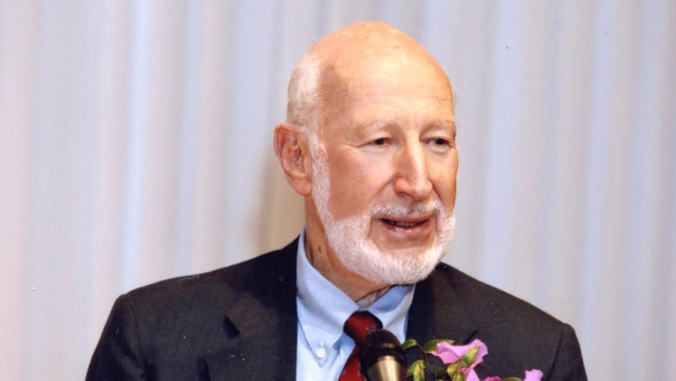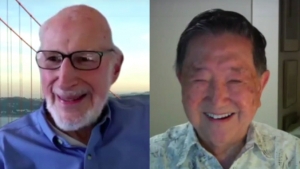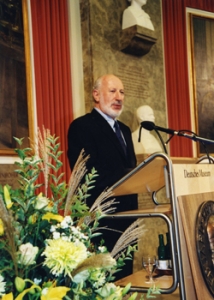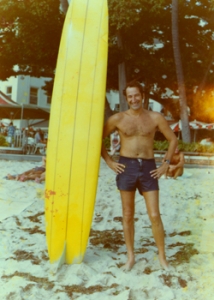
Norman Abramson, University of Hawaiʻi at Mānoa professor emeritus of electrical engineering and one of the founders of the pioneering ALOHAnet system, died December 1, 2020, at the age of 88.
Abramson came to UH Mānoa’s College of Engineering as a faculty member in 1966, and served as a professor of electrical engineering and professor and chair of the Information and Computer Sciences Department, until his retirement in 1996. Prior to joining UH, Abramson earned degrees from Harvard, UCLA and Stanford, and served a faculty member at Stanford and as a visiting professor at Harvard, UC Berkeley and MIT.
ALOHAnet’s impact

At UH Mānoa, Abramson teamed up with faculty member Franklin Kuo, with assistance from other faculty members and graduate students, to develop ALOHAnet, the basis of all wireless communications today—including mobile, satellite, cellular and WiFi. Debuted in 1971, ALOHAnet was the first system to transmit data between computers using radio waves. The novel approaches developed led to the development of Ethernet and wireless communication technologies used to this day.
In October 2020, Abramson and Kuo spoke at a virtual ceremony, dedicating ALOHAnet as an Institute of Electrical and Electronics Engineers (IEEE) milestone. The event was attended by UH Mānoa electrical engineering alumnus Gov. David Ige, UH President David Lassner, UH Mānoa Provost Michael Bruno, College of Engineering Dean Brennon Morioka, Google Chief Internet Evangelist and “Father of the Internet” Vint Cerf, and others. Abramson highlighted the technological advances in the decades after ALOHAnet.
Abramson said, “Whenever you pick up your telephone and make a phone call or use some other applications from that telephone, the very first thing you do is a packet comes from that telephone and the packet says ‘ALOHA.’”
Former colleagues and students of Abramson said the name ALOHAnet was fitting of his legacy because wherever he went, he brought the spirit of aloha with him.

“We are all saddened at the passing of Dr. Norm Abramson,” Lassner said. “There are very few people who had as significant an impact as Norm on the way the entire planet communicates and shares information today. He inspired colleagues and students to set aside conventional thinking, to develop fundamental new concepts, and to prove their ideas by engineering working systems. Norm linked the islands of Hawaiʻi to each other and to the world, leaving a legacy at UH and beyond through his ideas and his students.”
Lassner added, “I am personally grateful to have learned from him and to have been able to build in small ways on his groundbreaking work to keep Hawaiʻi connected to the world. Our deepest condolences to his wife, Joan, and the family on Norm’s passing.”
ALOHAnet pioneered the concept of wireless packet communication over a shared medium. It successfully demonstrated a novel approach for multiple devices to utilize a shared communication medium. Prior to ALOHAnet, a node on a network would talk directly to a node at the other end of the link. ALOHAnet nodes communicated on the same frequency by allowing each client to send its data when it was ready. The revolutionary ALOHA protocols devised by the ALOHAnet team provided for an acknowledgment/retransmission scheme to deal with collisions. This approach radically reduced the complexity of the protocol, and was the basis for the subsequent development of Ethernet and later WiFi.
“Although I only got to know Norm and Joan over the last year, they have had an amazing impact on me and my time here at the College of Engineering,” Morioka said. “Norm had a special presence about him, but you could instantly tell he was a very caring person. As much as his intellectual contributions helped to change the world to what we know it as today with all the technology we have grown accustomed to and rely on for our everyday activities, I think the impact he had on his many students and colleagues will be the longest lasting legacy that Norm has left us. I wish I had been able to know Norm longer than I did, but I am grateful to Norm and Joan for inviting me into their lives.”
Awards and accolades

Abramson was a consulting expert in communication systems, data networks and satellite networks for the International Telecommunications Union in Geneva, UNESCO in Paris and UNDP in Jakarta. He holds eight U.S. and international patents, and was one of more than 60 UH patent holders honored in 2015 when UH joined the National Academy of Inventors.
Abramson is the recipient of several prestigious international awards including the 2007 IEEE Alexander Graham Bell Medal; 1995 IEEE Koji Kobayashi Computers and Communications Award; 2000 Technology Award from the Eduard Rhein Foundation; and 2011 NEC Computer and Communications Award.
Abramson is survived by his wife, Joan, son Mark (Rose de Heer) and three grandchildren. His daughter, Carin Abramson Wethington, who passed away in 2014, was a UH Mānoa electrical engineering alumna.

